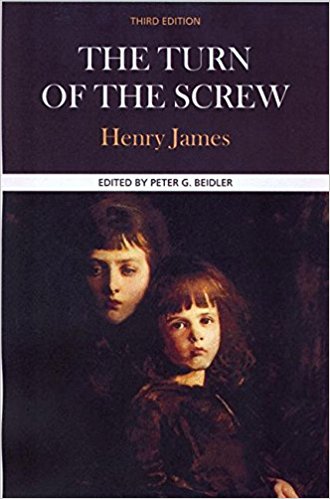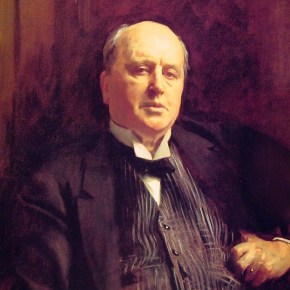The Turn of the Screw Summary
8 min read ⌚
 Ready for some gothic whodunnit ghost mystery which includes children and a strange governess?
Ready for some gothic whodunnit ghost mystery which includes children and a strange governess?
If so, you’re going to love Henry James’ “The Turn of the Screw.” It has been adapted numerous times in all media available – so you know it’s scary and appealing.
Bonus: it’s also a literary classic!
Who Should Read “The Turn of the Screw”? And Why?
Sometimes, even great writers need a break.
In your case, that means binge-watching a 10-season-long TV show for a week or so and eating unhealthy amounts of chips and pizza.
In Henry James’ case, it means writing “a shameless pot-boiler” (Henry James’ words, not ours) literary critics will have a hard time understanding to this day.
“The Turn of the Screw” is no more than one hundred pages long – but even if it was thrice as long, you would have still read it in a breath and a few goosebumps.
People who like gothic stories such as “Flowers in the Attic” will enjoy every sentence of this short novel. Those of you who like detective stories – put your Sherlock Holmes hats on!
This ghost mystery is anything but simple.
Henry James Biography
Henry James was an American-born novelist so enamored with British culture that he acquired British citizenship few months before his death.
was an American-born novelist so enamored with British culture that he acquired British citizenship few months before his death.
He is widely considered the most important transitional figure between Realism and Modernism in American literature, lauded by many for both his mastery of style and his profound understanding of human nature.
Henry James is the author of numerous books which are considered classics to this day, among them “The American,” “The Portrait of a Lady,” “What Maisie Knew,” “Daisy Miller,” and “The Ambassadors.”
The son of famous American Swedenborgian Henry James Sr., Henry James was also the brother of William James and Alice James, the former “The Father of American psychology,” the latter a celebrated diarist.
Henry James was nominated three times for the Nobel Prize in Literature (1911, 1912, and 1915).
Plot
Before we begin telling you the story of “Turn of the Screw,” we need to tell you two things about it.
Number one: Steven Spielberg is currently producing an adaptation of the novel.
So, if you want to be surprised when that film inevitably comes to cinema in half a year or so – spoiler alert!
Number two: it better be a good one, because “Turn of the Screw” has already served as the basis of three brilliant movies.
And you may already know one of them: Nicole Kidman’s “The Others”!
The other two are British films from 1961 and 1971, “The Innocents” and “The Nightcomers.” The second one is actually a great prequel, and the former one is – and we’re not joking about this – is one of the scariest movies ever made.
Don’t believe us?
Believe Martin Scorsese, who seems to share with us the same opinion.
Time for a trailer which does little justice to a fantastic movie:
On with the plot.
The main story in the novella is actually a story-within-a-story, read from a manuscript by a certain man named Douglas to our unnamed narrator.
We soon learn that the manuscript was written by the chief protagonist, a former governess who is hired by a man to watch over his nephews, whom he is responsible for after the premature deaths of their parents.
Being a man, he is not very interested in raising the children; and our governess, being a woman, thinks they are the most beautiful children she has ever seen; and also thinks that their uncle is a bit of a catch?
Boy – that sentence sounded sexist!
Sorry, Virginia Woolf – we only meant it to be funny.
Although we can now see how it is not.
Anyway, the boy is called Miles and is at the moment attending a boarding school; the girl’s name is Flora, and she is living in Bly, Essex, at a summer country house.
Its housekeeper, Mrs. Grose, is currently in charge of her, because, well, we already said that their uncle – who leaves to his other house in London – wants to have nothing to do with them.
In fact, that’s precisely what he tells the Governess, imploring her not to bother him with any questions whatsoever.
“But, what If – “
“No, buts!”
That’s not their actual communication, but you get the point.
Miles soon returns to Bly.
You’d think that it’s because it’s summer and there’s no school for summer, but no! Soon after him, a letter written by the school’s headmaster reaches the summer house stating that Miles is expelled.
Why, you wonder?
We don’t know. What we do know is that it’s something so scary that the headmaster explicitly states that Miles is never to be allowed back.
The Governess is already worried, but Miles is just too charming! In fact, she can think of nothing that a boy like him would ever be able to do that would grant an expulsion from school!
And everything’s nice and tidy for a while, but then strange things start to happen.
Like – really strange!
First of all, one evening, the Governess sees a strange male figure on one of the towers of the castle. And to make matters worse, that peculiar figure reappears a few days later, eerily peering through the dining room window.
Interesting trivia: the Governess is not in the dining room.
Then who is that strange guy looking for?
The Governess describes the man to Mrs. Grose, and she realizes right off the bat that, judging by his description, it could be none other but Peter Quint, a former servant at the house.
Pheew, that was close!
Mystery solved now, right?
No – not in the least bit!
In fact, there’s an even bigger mystery now!
Because, you see, Peter Quint is dead.
So, since it’s the 19th century, it’s obvious what’s happening: a ghost of a former servant is haunting the house where he had previously worked.
Ghost?
Scratch that: it’s ghosts!
Because just a few days later, as the Governess is watching over Flora, she notices another figure – this time a female.
She puts two and two together and concludes – mightily quick, we may add – that it must be the ghost of her predecessor, Miss Jessel.
It’s a long mental journey going from no ghosts to one ghost, but a pretty brief one from one to two ghosts, right?
Soon, things get even scarier, since the next time the Governess sees the ghosts, they are in the house!
And as if that is not enough, in the meantime, the Governess unravels a couple of new things which make everything seem even more disturbing!
First of all, she learns from Mrs. Grose that, when alive, Peter Quint and Miss Jessel were… khm, ahem… lovers.
Secondly, they were also around the children for most of the time before they died.
And thirdly, the Governess notices that Miles and Flora may be able to see them as well!
But they are not telling her!
One evening, late at night, she sees something which will undoubtedly make your hair stand and your blood freeze if you saw it yourself.
Flora is looking out the window of her room at someone on the lawn below her, but that someone is looking up at someone else who is somewhere above her. And that someone on the law, we learn in a second, is none other than Miles!
Do what you can do, you Governess, you: something shady is going on here, and we don’t even want to know what it is!
Just save the children!
The Turn of the Screw Epilogue
A few days later, Flora leaves the house while Miles is playing some music for the Governess.
The Governess and Mrs. Grose go in search for her, and they find her on the shore of the lake where the Governess has first seen the ghost of Miss Jessel.
The Governess is bent out of shape!
She accuses Flora of not telling her the truth, the whole truth, and nothing but the truth! Flora denies that she is doing anything of that sort, claiming that she has seen no one and adding that she doesn’t want to see the Governess ever again.
The Governess is one step ahead of Flora and arranges for Flora, accompanied by Mrs. Grose, to go to London to her uncle.
The Governess had already sent him a letter informing him about this.
So much for that not bothering part!
Well – not exactly!
It turns out that the letter has been burnt by Miles, which means that his uncle is about to have some unexpected visitors.
But, that’s certainly not the most exciting part of the story.
Back to Bly, Miles – who, in the meantime, has really grown to like the Governess – finally opens up to her about the things he did which got him expelled.
As this is happening, the ghost of Quint appears at the window.
Miles attempts to see it, but the Governess hugs him and grasps him tight in her arms, trying to shield him from the sight of evil.
And, lo and behold, the ghost disappears.
A happy ending?
Oh, no, no, no, no, no, mister.
Because, you see, just like the Father in that beautiful Goethe poem, the Governess finds Miles in her arms motionless, dead.
Like this summary? We’d like to invite you to download our free 12 min app, for more amazing summaries and audiobooks.
“The Turn of the Screw PDF Quotes”
No, no—there are depths, depths! The more I go over it, the more I see in it, and the more I see in it, the more I fear. I don’t know what I don’t see—what I don’t fear! Click To Tweet Of course I was under the spell, and the wonderful part is that, even at the time, I perfectly knew I was. But I gave myself up to it; it was an antidote to any pain, and I had more pains than one. Click To Tweet There was nothing in the room the next minute but the sunshine and a sense that I must stay. Click To Tweet All roads lead to Rome, and there were times when it might have struck us that almost every branch of study or subject of conversation skirted forbidden ground. Click To Tweet We were alone with the quiet day, and his little heart, dispossessed, had stopped. Click To TweetOur Critical Review
You can never go wrong with a chilling gothic story about a caring Governess, two wicked ghosts and two innocent children, one of which dies during the course of events.
Especially, if you are ambiguous.
Because, you see, the story we told you above sounds even creepier when you hear some of the early interpretations.
Some, simply put, were not that keen on believing the Governess right from the start. And a group of them pointed out that she was the only one able to see the ghosts.
And, then, a famous literary critic interested in the Freudian undertones of the literary classics going by the name of Edmund Wilson, suggested something eerie.
Namely, what if the ghosts are figments of the Governess’ imagination and she is, in fact, the one who is insane due to her sexual repression (it’s Freud, after all)?
To this day, many think that this is the real story behind “The Turn of the Screw.”
And we think that, at this point, there’s absolutely no reason to recommend this exceptional novella.
Emir is the Head of Marketing at 12min. In his spare time, he loves to meditate and play soccer.







